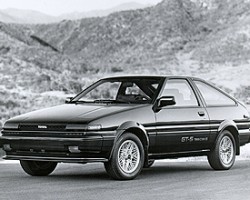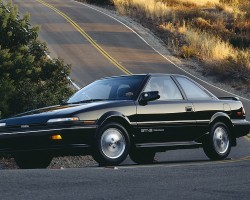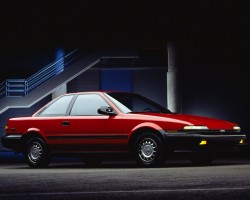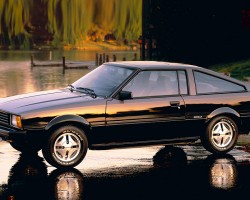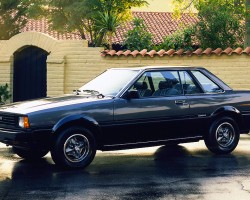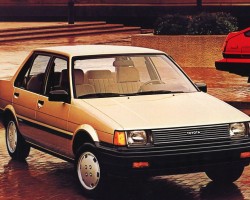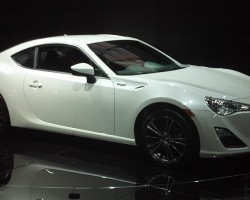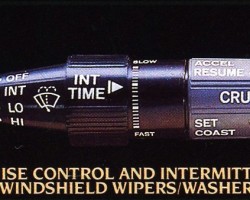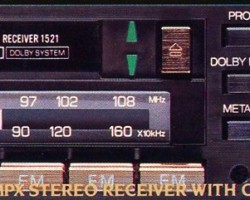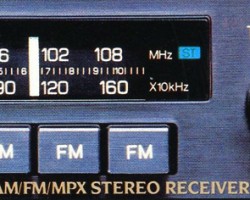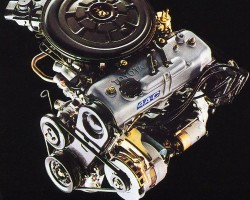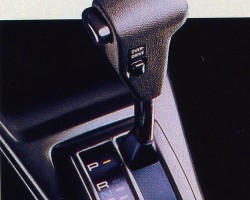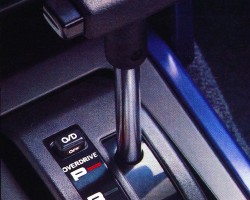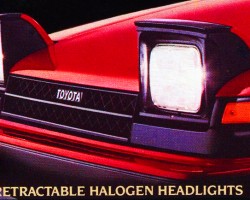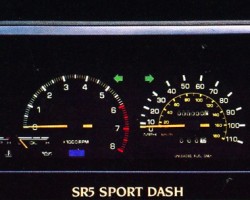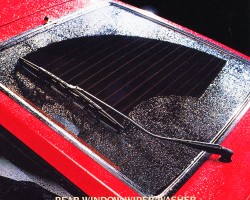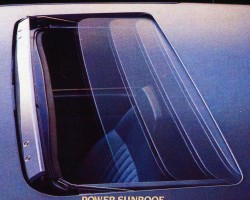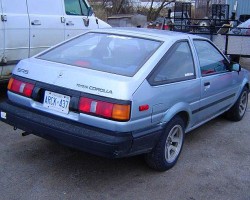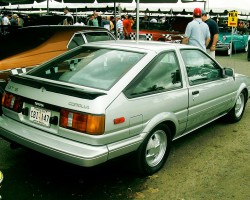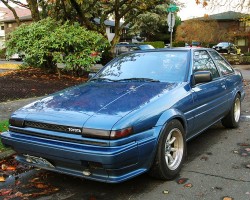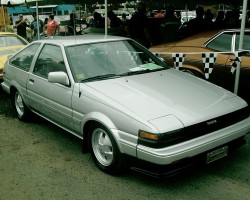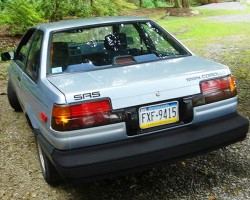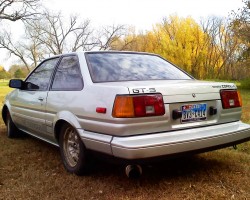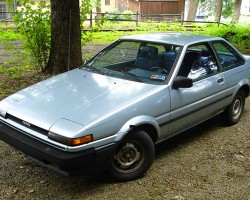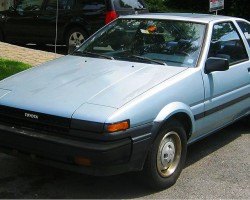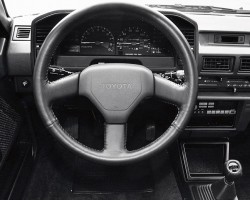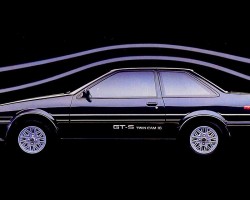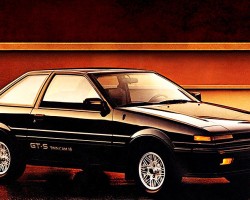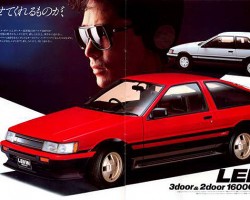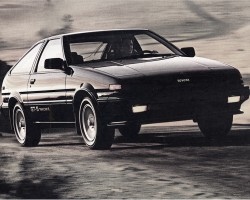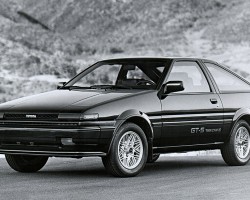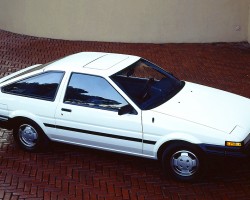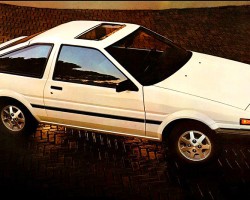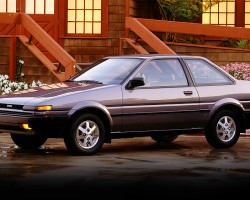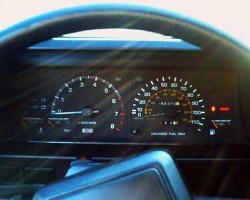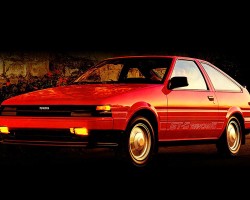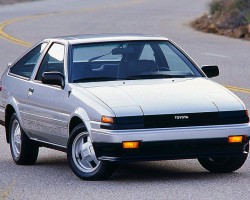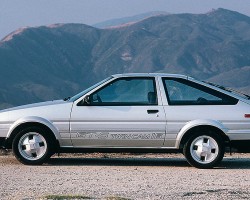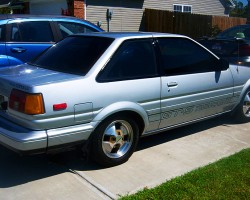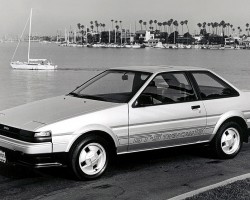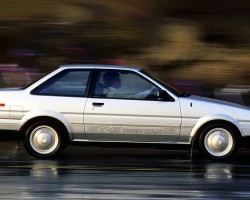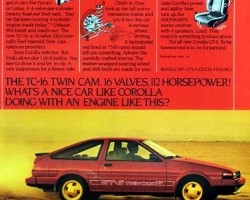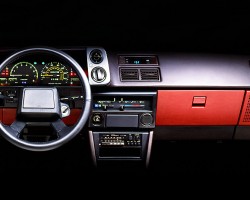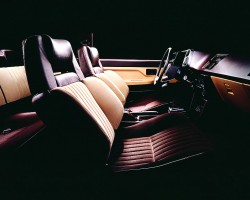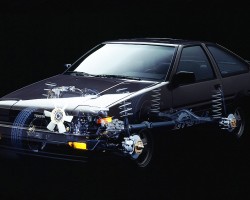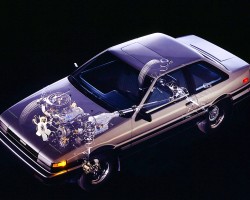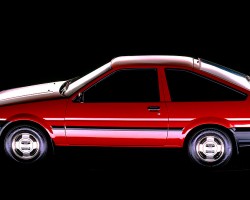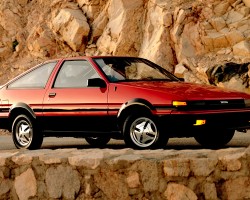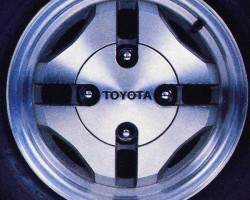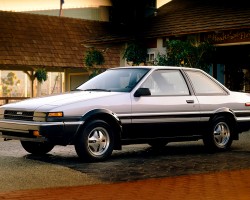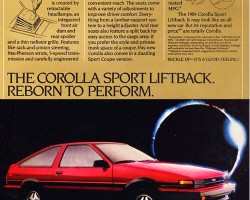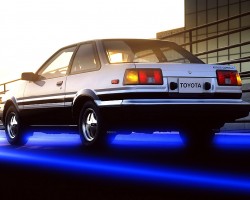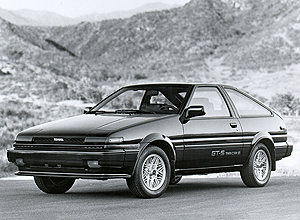
The GT-S version of the Corolla Sport from 1985-87 featured advanced engineering such as a cylinder head with dual overhead engine camshafts and 4 valves per cylinder, fuel injection, 4 wheel disc brakes, and more. 1986 GT-S hatchback shown.
Looking for a modestly priced rear-wheel-drive car that’s fun-to-drive and has collector appeal? How about one that gets over 40 miles per gallon?
Often cars we find most collectible have a unique mixture of last-of-its-kind and first-of-its-kind attributes. Popular “last” or “first” attributes can be styling, technology, a particular engine, body style, drive train layout, size, and much more.
(A slide show with pictures of all 1984 – 1987 Corolla Sport coupe variations is at the end of this article.)
We offer the “AE86”generation of the Toyota Corolla for consideration in this elite class of automobile, despite it’s humble origins as a small, lightweight coupe produced as part of the fifth generation Corolla design.
WHY THE COROLLA SPORT COUPE IS A CAR WITH “OVERLAPPING APPEAL” WORTH OWNING:
- It’s the last car of its kind with rear-wheel-drive. By 1984, all Japanese, European, and American low-priced economy cars sold in the United States had switched to front-wheel-drive except the subcompact Chevrolet Chevette of 1976-87 and the Corolla coupe. Even the Corolla 4-door sedan now featured front-wheel-drive. While possible to purchase more expensive rear-wheel-drive cars during the mid-1980s, buyers of economy cars were pretty much out of luck if they wanted the sporty handling and performance advantages traditional rear-wheel-drive offered.
- In GT-S form, the Corolla coupe was equipped with advanced mechanical features that didn’t become mainstream on more expensive cars until a decade later. Fuel injection, dual overhead engine camshafts, 4 valves-per-cylinder, disc brakes on front and rear wheels, and limited-slip rear differential were standard. On base SR5 models, a 4-speed automatic transmission with overdrive was available – superior to 3-speed automatics many cars in this price class offered then.
- While engine systems were advanced, it’s lack of other complex systems such as airbags, anti-lock brakes, stability control systems, and adaptive suspension put this car more in the mechanically simple category than not. As a whole, cars this easy to maintain haven’t been produced in decades, so the Corolla coupe has last-of-its-kind appeal in this category.
- Its light weight (approximately 2,200 pounds) gives the Corolla coupe a decidedly old-school sports car appeal. Weighing far less than any small car today makes it easy to drive, and adds to fun-to-drive tossable handling characteristics as well as a great economy rating of 42mph highway. However, disadvantages of its light weight are lack of crash worthiness and occupant protection due to the absence of modern impact-absorbing vehicle frame design, and airbags.
- Its more modern styling ditched the awkward, truncated look many small Japanese cars suffered from since the 1960s. A low hood line, pop-up headlights, and clean wedge-shaped design brought a silhouette to the Corolla coupe that kept it fresh through the 1990s. Many feel it does not look out-of-place today.
- Original wheel sizes of 13- and 14-inches on the Corolla coupe are shopping-cart small relative to the large size of wheels on most of today’s cars (17″ through 20″). Tires for the Corolla coupe are inexpensive to buy, and their taller sidewall height allows for enough cushioning protection over potholes that blowouts are unlikely. However, the 14-inch aluminum wheels standard on GT-S models are lightweight and modern-looking in appearance, resulting in a good mix of first- and last-of-its-kind advantages in this category.
Fans of the final rear-wheel-drive Corolla series refer to it simply by its chassis code of “AE86”. Broken down, that designation refers to “A” (representing the 4-A series 1.6-liter engine), “E” representing the Corolla model line, “E” represents the Corolla, “8” represents the fifth generation, and “6” represents engine’s cylinder head (either a 6 marks the twin-camshaft, fuel-injected engine of 112 horsepower, or a 5 marks the single overhead cam base carbuerated version of 70 horsepower). In Japan, the AE86 was also known as the Hachi-Roku, Japanese for “eight-six”.
MECHANICAL SPECIFICATIONS
1984-87 SR5 models: 1.6-liter four cylinder engine with single overhead camshaft, two valves per cylinder, and 2-barrel carbuerator (72 horsepower). Front disc brakes, rear drum brakes. MacPherson strut style independent front suspension with four-link solid rear axle with coil springs. Transmission choices were 5-speed manual or 4-speed automatic overdrive.
1985-87 GT-S models: 1.6-liter four cylinder engine with dual overhead camshafts, four valves per cylinder, and fuel injection (112 hp). Front and rear brakes were discs. Limited slip rear differential standard. Front and rear antiroll bars equipped. A 5-speed manual was the only transmission choice.
CHANGES FROM YEAR TO YEAR
1984 – Introduced in the United States in two-door coupe and three-door liftback form.
- Both coupe and liftback were badged “SR5” and featured a 1.6-liter four-cylinder with single overhead camshaft and 2-barrel carbuerator (rather than fuel injection). This engine remained unchanged through 1987, and powered all SR5 models.
- Standard SR5 wheels were 13-inch steel wheels, equipped with center caps and trim rings. 13-inch styled aluminum alloy wheels were optional.
- Standard tire size on SR5s was 185/70-13 (remaining unchanged through ’87).
- A “Sport” package was offered as an option on ‘84s and featured sport seats, cloth map pockets (in place of hard plastic), adjustable driver’s seat, the alloy wheel option, and mud flaps front and rear.
- Seats were cloth on all SR5s. Interior colors were beige or blue.
- Optional features included sunroof, cruise control, air conditioning, power steering, power mirrors, and rear wiper on hatchback models only.
- A radiator fan shroud was added on models equipped with optional air conditioning
1985 (see an ’85 commercial on our youtube channel here https://youtu.be/RrbAc1Hj1DE)
- The high performance GT-S was introduced and added rear disc brakes, a sixteen-valve cylinder head (producing 112 horsepower), dual overhead engine camshafts, leather steering wheel & shift knob, rear spoiler (on hatchback versions), front air dam, 7,500 rpm tachometer, 150 mph speedometer, oil pressure gauge, painted bumper covers, the “Sport” package introduced the previous year, “GT-S” decals on fenders, doors, and quarter panels.
- GT-S models came standard with 14-inch aluminum alloy wheels and 185/60-14 tires. SR5 wheel & tire choices carried over unchanged from 1984.
- A limited-slip rear differential was optional on GT-S models only to reduce rear wheel spin.
- The “Sport Interior” package was no longer available on SR5 models, but standard on GT-S only.
- A clutch pedal cutoff switch requiring the clutch pedal to be depressed before the ignition would start was introduced into production February 1985.
- “SR5” and “GT-S” trunk badging was changed to flat decal lettering instead of 3-dimensional emblems on ‘84s.
- Brake lines changed from a 7-line setup to a 5-line setup May 1985.
- Interior color choices on SR5s were maroon, gray, and blue. GT-Ss were available in maroon and gray.
1986
- Corolla Sport receives a mid-cycle cosmetic update. On all models, tail lights were updated, black plastic garnish was added around headlight lids, side marker lights, trunks and license plates, and black plastic wheel arch trim was added to GT-S models only.
- Front grilles were enlarged to extend underneath front headlights, with bumper extensions now appropriately smaller.
- Center high mounted 3rd brake lights were added on all models to comply with U.S. federal regulations.
- “GT-S” side decals were reduced in size and came only on doors and trunks. No longer were fenders or quarter panels marked. Trunk decals for all models changed to a gradient design from the lined type.
- Rear trunk spoilers were no longer equipped on GT-S 2-door coupes but 3-door liftbacks still had them.
- Aluminum alloy wheels were redesigned. On GT-S, wheels were still 14 inches but featured a new snowflake pattern. Optional SR5 wheels were still 13 inches, but now featured a 7-spoke design and brushed aluminum facing. Base plain steel wheels on SR5s remained unchanged.
- Automatic transmission equipped models (SR5 only) featured a redesigned gear shift lever with the overdrive button on the shift knob instead of on the center console assembly.
- Interior cloth changed from tweed style cloth to velour with checker pattern on GT-S models. Door interiors received separate arm rests that bolted on in place of one-piece molded vinyl ones. Headliners and sun visors (now larger in size) changed from vinyl type to a fuzzy cloth type.
- Steering wheels were updated from a square center horn to a more rounded, 6-sided design.
- Gauge cluster illumination changed from green to white, and faint vertical lines were added to the cluster background surface. Needles also changed to white and featured redesigned markings. The dashboard clock lettering was now in black instead of being offset in white.
- Climate control panel buttons changed to an all-symbol design with a more textured feel to switch surfaces. Buttons on the dash for rear defogger, wiper, etc. now lit up when headlights were on.
- All models featured an improved clutch master cylinder designed to reduce squealing.
- A vacuum pump was added to the cruise control system for smoother operation.
- Other mechanical changes included a slightly smaller steering rack for weight reduction, improved fuel tank baffling to reduce fuel pump starvation around corners, and a new improved diagnostic terminal port.
- Interior color choices on SR5s were black, gray, and blue. GT-Ss were available in black and blue.
1987
- Three door “Liftback” models were dropped, leaving SR5 and GT-S coupes only for the ’87 model year. Otherwise, ‘87s were virtually a direct carryover from the previous year with several small interior differences.
- The “Sport Interior” package was again made optional on SR5s as it had been for 1984. Most SR5s were equipped with it. The package was standard on GT-S models.
- The interior material that was switched to velour the previous year was changed back to tweed type from 1984-85. Headrests changed to cloth type from vinyl on SR5s and GT-Ss without “Sport Interior”.
- Radio connectors changed to new Toyota standard plugs used on almost all Toyotas until 2000.
- Interior color choices on SR5s were black, maroon, and blue. GT-Ss were available in black and blue.
- Limited edition “Black Limited” AE86s were produced to commemorate the final production run of rear-wheel-drive ’87 Corollas before being replaced by the next generation 1988-92 front-wheel-drive AE92 Corolla coupe.
FINDING A USED ONE TODAY
Although Corolla coupes were sold in large numbers, most in northern “rust-belt” states have not survived the winter salt corrosion well and have gone to their graves. Many clean, original, good examples can still be found in southern and western warm climate states. Be careful when looking at GT-S models particularly – many of them have been modified by owners with varying levels of mechanical skill, and have been driven hard by fans of “drifting” (prolonged burn-outs which shred clutches, drive lines, differentials, and engine internals).
SPIRITUAL SUCCESSORS TO THE ORIGINAL AE86 ARE DUE IN SHOWROOMS DURING CALENDAR YEAR 2012 (AS 2013 MODELS).
The appeal of the 1984-87 AE86 Corolla Sport coupe today remains so strong among young drivers of different generations that Toyota product planners were inspired to create a spiritual successor. One that combines rear-wheel-drive sports car handling with simplicity and low cost as the original did.
To cut costs, Toyota teamed up with Japanese automaker Subaru to jointly develop a platform for both car makes to sell a version of. Codenamed “FT-86” to commemorate the original AE86, design and body panels were engineered by Toyota while engines and drive train work were done by Subaru.
As such, the Subaru engine powering both versions will be a 2.0-liter four-cylinder engine with cylinders laid out in typical flat, horizontally opposed Subaru fashion. Direct fuel injection enables the new powerplant to create 200 horsepower without the use of a turbocharger or supercharger. 6-speed manual and 6-speed automatic transmissions will be available.
In the United States, Toyota will sell its version (to be called FT-S) under its Scion brand – in all other markets, it will be simply badged a Toyota. Subaru’s version has been dubbed the BRZ. Unlike all current Subarus which feature standard all-wheel-drive, the BRZ is planned to remain the company’s only rear-wheel-drive offering.
I’ll take mine in black, please.
-Sean
SLIDE SHOW. CLICK ON ANY OF THE PICTURES IN THE SLIDE SHOW BELOW TO EXPAND TO FULL SIZE. USE ARROWS UNDERNEATH PICTURES TO SCROLL BACKWARD OR FORWARD.
- The GT-S version of the Corolla Sport from 1985-87 featured advanced engineering such as a cylinder head with dual overhead engine camshafts and 4 valves per cylinder, fuel injection, 4 wheel disc brakes, and more. 1986 GT-S hatchback shown.
- The following generation (1988 – 1991) of Corolla GT-S coupes were also front-wheel-drive. (Photo credit: Toyota Motor of North America, Inc.)
- The next generation 1988 – 1991 Corolla Sport coupes switched to front-wheel-drive. Shown: 1988 Corolla SR5. (Photo credit: Toyota Motor of North America, Inc.)
- The prior generation Corolla SR5 hatchback of 1980 – 1983. ’83 model shown.
- Shown for reference is the previous generation 1980-83 Corolla SR5 notchback coupe. All Corollas of this prior style (sedans and coupes) were rear-wheel-drive.
- The 4-door sedan version of the 1984-87 Corolla. While both sedans and Sport coupes used the same 1.6-liter engine, the sedan was switched to a front-wheel-drive platform. U.S. market 1984 Corolla LE sedan shown. (Photo credit: Toyota Motor of North America, Inc.)
- Inspired by the cult popularity of the 1984 – 1987 Corolla Sport, Toyota is bringing to market the new-for-2013 Scion FT86. The “86” is named for the Corolla Sport’s original “AE86” platform name. (Photo credit: Sean Connor)
- Cruise control and intermittent wipers were available on all models. Controls were mounted on a stalk protruding from the right side of the steering column, as this 1984 brochure picture shows. (Photo credit: Toyota Motor of North America, Inc.)
- The AM/FM stereo cassette radio optional on SR5s, standard on GT-S models. (Photo credit: Toyota Motor of North America, Inc.)
- Base radio on Corolla SR5 models was an AM/FM stereo radio, as shown in the 1984 brochure. (Photo credit: Toyota Motor of North America, Inc.)
- The 1.6-liter four-cylinder engine that powered all Corolla Sport and sedan models from 1984 – 1987. (Photo credit: Toyota Motor of North America, Inc.)
- For 1986 – 1987, 4-speed automatic gearshift levers were redesigned and looked like this one.
- A 4-speed automatic overdrive transmission was optional on Corolla Sport SR5 coupes during 1984 – 1987. Gear shift levers looked like this for 1984 and ’85. (Photo credit: Toyota Motor of North America, Inc.)
- Pop-up headlights were popular in the the 1980s, and all U.S. 1984-87 Sport coupes were equipped with them. U.S. market 1984 Corolla Sport SR5 shown.
- The Corolla SR5 instrument cluster, as shown in the U.S. model 1984 brochure. (Photo credit: Toyota Motor of North America, Inc.)
- The rear wiper arm equipped on 1984 – 1986 U.S. Corolla Sport hatchback models. (Photo credit: Toyota Motor of North America, Inc.)
- All 1984-87 Corolla Sport models were available with an optional sunroof, as shown in this 1984 brochure picture. (Photo credit: Toyota Motor of North America, Inc.)
- For 1986, both SR5 and GT-S hatchbacks received new tail light assemblies. The Toyota logo was moved from above the center license plate to the passenger side of the tailgate. 1986 Corolla SR5 hatchback shown with non-original wheels. (Photo credit: A. Vona)
- A view of the 1984 – 1985 style tail light assembly on SR5 and GT-S coupes. 1985 Corolla GT-S hatchback shown. (Photo credit: D. Walsh)
- Front end revisions on GT-S Corollas included a revised front bumper cover. Front grilles were enlarged to extend underneath front headlights and were painted body color on top. Toyota emblems moved from the center of the grille to the driver’s side. (Photo credit: C. Pressler)
- Unlike SR5s, Corolla GT-S models featured painted bumper covers front and rear. 1985 GT-S hatchback shown.
- For comparison, 1986 – 1987 SR5 and GTS notchback coupes featured these revised tail lights. Center high mounted brake light assemblies were added in 1986 per U.S. federal regulations. 1987 Corolla SR5 notchback coupe shown. (Photo credit: H. Dlugatch)
- 1984 and 1985 Corolla notchback coupes had tail lights that looked like this. 1985 GT-S notchback coupe shown. (Photo credit: S. Garcia)
- For 1986 – 1987, the trim piece underneath the front grille and headlights was painted body color instead of being left black on SR5 models. 1987 Corolla SR5 notchback coupe shown. (Photo credit: H. Dlugatch)
- 1984 – 1985 Corolla SR5s featured a completely black look on the front bumper, grille, and headlight edges. 1985 Corolla SR5 hatchback shown. (Photo credit: E. McMaster)
- Interior view of a 1987 Corolla GT-S coupe. (Photo credit: Toyota Motor of North America, Inc.)
- 1986 and 1987 GT-S notchback coupes no longer featured trunk spoilers. 1987 Corolla GT-S coupe shown.
- For 1987, hatchback versions of the Corolla Sport were dropped, leaving this GT-S coupe shown and base SR5 coupe. (Photo credit: Toyota Motor of North America, Inc.)
- In other markets, the Corolla Sport was known as the “Levin”. 1986 advertisement shown. (Photo credit: Toyota Motor Inc.)
- 1986 was the last model year for the three-door liftback body style in the U.S. Shown is a U.S. market 1986 Corolla Sport GT-S three door liftback. (Photo credit: Toyota Motor of North America, Inc.)
- For 1986-87, Corolla Sport GT-S models featured these revised aluminum wheels, smaller GT-S decals, and redesigned bumpers. U.S. market 1986 Corolla Sport GT-S hatchback shown. (Photo credit: Toyota Motor of North America, Inc.)
- This view of a 1986 SR5 hatchback shows the base level bumpers that were unpainted, and 13-inch standard steel wheels. (Photo credit: Toyota Motor of North America Inc.)
- 1986 Corolla SR5 hatchback with the 14-inch factory accessory wheels. (Photo credit: Toyota Motor of North America, Inc.)
- Optional 14-inch aluminum wheels were redesigned as shown here for 1986-87. 1986 SR5 coupe shown. (Photo credit: Toyota Motor of North America, Inc.)
- 1985 Corolla GT-S left front view. (Photo credit: Toyota Motor of North America Inc.)
- 1985 Corolla GT-S hatchback right front view. (Photo credit: Toyota Motor of North America, Inc)
- Side view of the hatchback version of the new-for-1985 Corolla GT-S. (Photo credit: Toyota Motor of North America, Inc)
- A 1985 Corolla Sport GT-S notchback coupe.
- Left front view of the new-for-’85 Corolla Sport GT-S notchback coupe. (Photo credit: Toyota Motor of North America, Inc)
- A 1985 Corolla Sport GT-S notchback coupe.
- This U.S. market advertisement introduces the new GT-S version of the Corolla Sport for 1985, available in coupe and liftback form. (Photo credit: Toyota Motor of North America, Inc.)
- 1984 TOYOTA COROLLA SR5
- A U.S. market 1984 Corolla Sport SR5 three-door liftback. (Photo credit: Toyota Motor of North America, Inc.)
- Aluminum alloy wheels of this design were available on base SR5 coupe models from 1984 – 1985. (Photo credit: Toyota Motor of North America, Inc.)
- 1984 TOYOTA COROLLA SR5 notchback coupe
- This U.S. market advertisement introduces the three-door liftback version of the 1984 Corolla Sport SR5. (Photo credit: Toyota Motor of North America, Inc.)
- The Corolla Sport Coupe was introduced for model year 1984 as a two-door notchback coupe (shown) and three-door hatchback. Both versions were sold in SR5 trim only for 1984.

